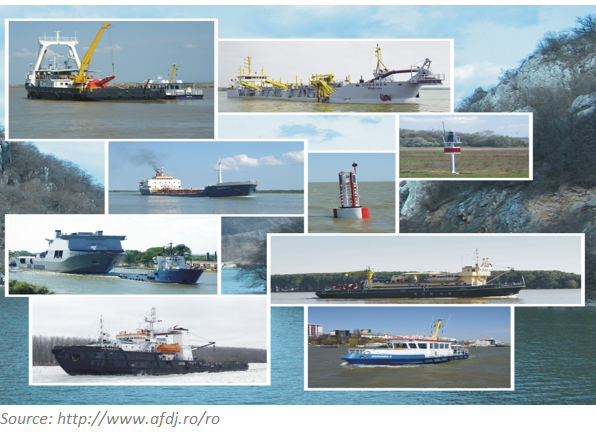Promotion for Boatmaster category A licence
Scope
The training program is addressed to inland navigation personnel wishing to obtain Boatmaster Category A licence.
Objectives
Acquiring the theoretical knowledge needed a permanent assimilation of the specific notions provided into the syllabus modules;
Stimulating trainees' interest in learning, realizing that after course graduation they will actually work, exploit and effectively participate in the maintenance of shipboard facilities;
Developing the skills to act effectively for the safe operation of the ship and its on-board facilities.
Specific competencies
At the end of the program, trainees must be able to:
Know and interpret the special rules of navigation on the Danube river, the entrance to the Danube ports, at the passage under the bridges and locks;
Identify and describe the difficult sectors for navigation on the Danube river;
Manoeuvre and handle the vessels/convoys on inland waterways under any hydrological conditions of the navigable waterway, in all weather conditions, including in emergency situations;
Efficiently act in the emergencies appeared during the operation of the vessel;
Know and use the standard communication vocabulary in Danube navigation.
Participants
The training program is addressed to inland navigation personnel who own the Helmsman licence and wishes to obtain the Boatmaster Category A licence.
Minimum participation conditions
Helmsman licence;
Have navigation time as Helmsman of not less than 4 years;
Secondary education.
Reference documents
Ministry of Transport Order no. 318/2006 on approval of standards of training, competency confirmation and issuing of certificates of competency for inland navigation
Specific themes
Stretches with specific risks from national and international sector of the Danube;
Fairway characteristics (water levels variations, water flow, depth, width, length, radius of curvature recommended for Danube navigable sectors);
Navigation infrastructure (locks, bridges, port terminals);
Regularization works (groynes, longitudinal breakwaters, bank protection, traverse for directing water flow etc.) along the Danube;
Types of convoys recommended on various sectors of the watercourse;
Coastal markings and floating on waterways, navigation signalization by day and by night, sound signals for navigation;
Traffic control system-RIS.
Promotion for Helmsman licence
Scope
The training program is addressed to inland navigation personnel wishing to obtain the Helmsman licence.
Objectives
Acquiring the theoretical knowledge needed a permanent assimilation of the specific notions provided into the syllabus modules;
Stimulating trainees' interest in learning, realizing that after course graduation they will actually work, exploit and effectively participate in the maintenance of shipboard facilities;
Developing the skills to act effectively for the safe operation of the vessel and its on-board facilities.
Specific competencies
At the end of the program, trainees must be able to:
Know and interpret the special rules of navigation on the Danube river, the entrance to the Danube ports, at the passage under the bridges and locks;
Identify and describe the difficult sectors for navigation on the Danube river;
Manoeuvre and handle the vessels/convoys on inland waterways under any hydrological conditions of the navigable waterway, in all weather conditions, including in emergency situations;
Efficiently act in the emergencies appeared during the operation of the vessel;
Know and use the standard communication vocabulary in Danube navigation.
Participants
The training program is addressed to inland navigation personnel who own the Boatman certificate and wishes to obtain the Helmsman licence.
Minimum participation conditions
Boatman certificate;
Have navigation time as Boatman of not less than 2 years;
Gymnasium studies.
Reference documents
Ministry of Transport Order no. 318/2006 on approval of standards of training, competency confirmation and issuing of certificates of competency for inland navigation.
Specific themes
Stretches with specific risks from national and international sector of the Danube;
Fairway characteristics (water levels variations, water flow, depth, width, length, radius of curvature recommended for Danube navigable sectors);
Navigation infrastructure (locks, bridges, port terminals);
Regularization works (groynes, longitudinal breakwaters, bank protection, traverse for directing water flow etc.) along the Danube;
Types of convoys recommended on various sectors of the watercourse;
Coastal markings and floating on waterways, navigation signalization by day and by night, sound signals for navigation;
Traffic control system-RIS.
Boatman Qualification
Scope
The training program is addressed to inland navigation personnel wishing to obtain the Boatman certificate of qualification.
Objectives
Acquiring the theoretical knowledge needed a permanent assimilation of the specific notions provided into the syllabus modules;
Stimulating trainees' interest in learning, realizing that after course graduation they will actually work, exploit and effectively participate in the maintenance of shipboard facilities;
Developing the skills to act effectively for the safe operation of the ship and its on-board facilities.
Specific competencies
At the end of the program, trainees must be able to:
Identify the vessel's structural and strength elements;
Contribute to vessel’ and on-board facilities’ maintenance;
Effectively exploit the vessel on-board facilities;
Intervene in shipboard emergency situations using the facilities and equipment specific to each situation;
Understand the orders received for vessel maneuvering;
Carry out on-board duties in compliance with health and safety at work standards.
Participants
The training program is addressed to inland navigation personnel who wish to obtain the Boatman certificate of qualification.
Minimum participation conditions
Not be less than 16 years of age;
Gymnasium studies;
Meet the applicable standards on physical and psychological health.
Reference documents
Ministry of Transport Order no. 318 of 2006 on approval of standards of training, competency confirmation and issuing of certificates of competency for inland navigation,
Government Decision no. 868/2015 on approval of Administrative Agreement on the mutual recognition of Boatmen Qualification course between CCNR and RO MT.
Specific themes
Hydrological and navigational characteristics of waterways;
Regularization works (groynes, longitudinal breakwaters, bank protection, traverse for directing water flow etc.) along the Danube;
Navigation infrastructure (locks, bridges, port terminals);
Coastal markings and floating on waterways, navigation signalization by day and by night, sound signals for navigation;
Types of convoys recommended on various sectors of the watercourse;
Traffic control system-RIS.
Familiarization with River Information System and integrated tracking ship traffic on Inland Waterways
Scope
The training program is a useful tool for familiarization of both the navigation personnel and shore-based personnel with the RIS concept and the integrated tracking ship traffic on Inland Waterways.
Objectives
• Acquiring the theoretical knowledge needed a permanent assimilation of the specific notions provided into the syllabus modules.
Specific competencies
At the end of the program, trainees must be able to:
Know the RIS concept, applicable in tracking of ship traffic on Danube;
Know the frame architecture for RIS services;
Identify the services, functions or applications using RIS systems;
Disseminate information regarding the Member State obligations in respect of RIS services on navigable inland waterways;
Identify the possibilities of progressive development for various components of RIS services;
Identify the needs for RIS services harmonization.
Participants
The training program is addressed to both inland navigation personnel and shore-based personnel involved in activities related to inland waterway transport.
Minimum participation conditions
This training program can be attended by any graduate of secondary education who is or will be involved in using the RIS system.
Reference documents
Ministry of Transport Order no. 1057 of 2007 for harmonization of river information services (RIS) with those in the European Union.
Specific themes
RIS architecture: generals, parties involved, objectives, responsibilities, services, need for information;
RIS Systems: relationship between services and systems, individual services: fairway information services, traffic information services, traffic management services, support services for risk prevention, information services for logistic/ transport management, information about low enforcement.


